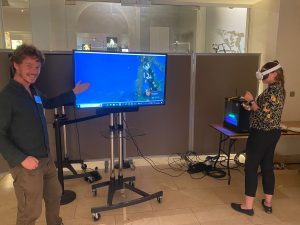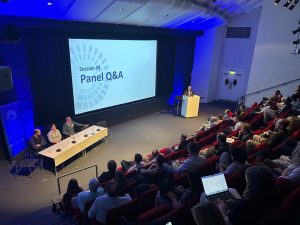The Structures in the Marine Environment (SIME) 2024 conference took place at the National Museum of Scotland on 22nd – 23rd May, showcasing the INSITE Phase 2 programme research from the last 3 years. The conference provided a chance for stakeholders from industry, government, and academia to come together for two days of knowledge exchange, discussions, and cross-sector networking across the science-policy interface to help understand what the future has in store for management of offshore structures in the marine environment.
“What will the end to our story look like? That is, at least in part, up to you!”
Prof. Colin Moffat, Chair of the ECOWind Project Advisory Group, in a rousing conference opening speech.
Showcasing the latest scientific findings
The conference kicked off with speakers from the ATSEA, NS3D and FISHSPAMMS projects, showing how autonomous systems and imagery analysis are helping to fill key evidence gaps and how virtual reality can be used to communicate science. In between conference sessions, delegates were invited to try NS3D’s communication tool by taking a virtual dive around an offshore structure, made possible by a Virtual Reality headset visualisation.

The day continued with speakers from FuECoMMS and ORbit discussing the benthic impact of offshore structures, along with the PLASTICS project which highlighted the issue of legacy plastics associated with oil and gas installations as an area of growing concern. With many questions to consider, delegates from all stakeholder groups were invited to attend a special PLASTICS workshop session the next day for further discussions.
The afternoon explored biodiversity, food webs and species interactions, including speakers from EcoSTAR, CHASANS and DREAMS, and finished with a session on the value of marine artificial structures including a talk from the SYNTHESIS project.
Policy-Science Interface
The second day of the conference opened up to allow government representatives to share their insights on the management of offshore structures in the marine environment. Professor John Paterson, from the University of Aberdeen’s Centre for Energy Law, set the scene with some of the policy, legal, and regulatory challenges in managing marine artificial structures. The sessions then began exploring the management and decommissioning challenges of marine artificial structures, ending with a panel discussion which featured the Offshore Petroleum Regulator for Environment and Decommissioning (OPRED), the Department for Food and Rural Affairs (DEFRA), NatureScot, and the INSITE Programme Director.
The 6th and final session of the conference then dived into opportunities for enhancing the impact of scientific research on policy-making processes with contributions from the INSITE Programme Director team, DEFRA, Natural England and Scotland’s Marine Directorate.
Conclusion
 As SIME 2024 came to a close, we also see the end of Phase 2 of the INSITE Programme. One key message resonated throughout the conference: the need for communication and collaboration across sectors to help better translate scientific findings into actionable policies and strategies for effective implementation. For example, there was recognition we are entering a challenging period for oil and gas decommissioning and need to consider whether the latest scientific findings support current decommissioning strategies. Cross-sector collaboration to necessary to tackle this challenge.
As SIME 2024 came to a close, we also see the end of Phase 2 of the INSITE Programme. One key message resonated throughout the conference: the need for communication and collaboration across sectors to help better translate scientific findings into actionable policies and strategies for effective implementation. For example, there was recognition we are entering a challenging period for oil and gas decommissioning and need to consider whether the latest scientific findings support current decommissioning strategies. Cross-sector collaboration to necessary to tackle this challenge.
The new Phase 3 of the INSITE programme and the Value of Marine Artificial Structures (ValMAS) Programme, jointly funded by a NERC-Industry partnership, with government support, are set to make waves in this very space. The new Programmes will investigate what environmental value Marine Artificial Structures have and how this weighs up against their legacy impacts and benefits to nature, society and the economy. Stay tuned for more news on Phase 3 in the Autumn 2024.
